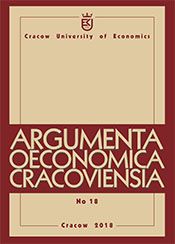Macroeconomic Stability in Poland against the Backdrop of Union Tendencies in Light of the Concept of MSP
Macroeconomic Stability in Poland against the Backdrop of Union Tendencies in Light of the Concept of MSP
Author(s): Aleksandra Jurkowska, Michał BodaSubject(s): Economy
Published by: Wydawnictwo Uniwersytetu Ekonomicznego w Krakowie
Keywords: economic policy; macroeconomic indicators; macroeconomic stability; Macroeconomic Stability Pentagon (MSP); MSP indicator
Summary/Abstract: This article aims to analyse the trends in the development of factors that determine the level of macroeconomic stability and to assess this level in Poland against the backdrop of different groups of European Union Member States (EU28 countries, Western Europe, Central and Eastern Europe, and Southern Europe) over the period 2006–2015 by using the Macroeconomic Stability Pentagon (MSP) method. The subjects of analysis in the presented method are the rate of economic growth (GDP), the unemployment rate (U), the rate of inflation (CPI), the public finance balance (G), and the country’s current account balance (CA). These values form the apexes of a pentagon scaled in such a way that the more desirable the indicator value, the further its corresponding apex is situated from the centre of the system. The article proposes establishing a joint area of the MSP based on a modified classic scale and a scale with regression (these approaches do / do not take into account, respectively, the negative influence of deflation on the general level of macroeconomic stability). The conducted analyses show that in recent years the EU28 countries have returned to the level of macroeconomic equilibrium prior to the crisis of 2008–2009. In Poland the MSP indicator has been growing since 2013 and has significantly exceeded the levels observed in Southern European countries. However, until 2015 its level was still lower than the average for the EU28 and the average set for the Central and East European countries. This was mainly due to the high level of unemployment, which despite a downward trend still remained above the EU average.
Journal: Argumenta Oeconomica Cracoviensia
- Issue Year: 2018
- Issue No: 18
- Page Range: 11-31
- Page Count: 21
- Language: English

